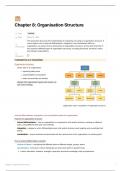🗂️
Chapter 8: Organisation Structure
Type Lecture
Date @April 8, 2024
This document discusses the fundamentals of organizing, focusing on organization structure. It
covers topics such as internal differentiation, integration, and coordination within an
Description organization, as well as the two dimensions of organization structure: vertical and horizontal. It
also explores different types of organization structures, including functional, divisional, matrix,
and network organizations.
Reviewed
FUNDAMENTALS OF ORGANISING
Organisation structure:
shows how in an organisation:
reporting takes place
responsibilities are assigned
tasks and activities are divided
aligned with organisation’s goals and mission, as
part of the strategy
Internal differentiation, integration, and coordination within the organisation
Features of organisation structure:
internal differentiation = how an organisation is composed of units and/or divisions, working on different
tasks, using different skills and work methods
integration = degree to which differentiated work units and/or divisions work together and coordinate their
efforts
coordination = how procedures and processes link the various parts of an organisation, to achieve goals
How is internal differentiation created?
division of labour → assigning the different tasks to different people, groups, teams
specialisation → process in which individuals and units each perform specific tasks
criteria: education, interests, strengths, expertise, technical knowledge, built-up experience
Chapter 8: Organisation Structure 1
, THE TWO DIMENSIONS OF ORGANISATION STRUCTURE
1. Vertical dimension
authority, responsibility, hierarchy, span of control, delegation, (de-)centralisation
how to report? how are authority and responsibility structured?
authority → the legitimate right to make decisions on resources and to tell other people what to do
responsibility → obligation to carry out tasks correctly ⇒ glue within the hierarchy
hierarchy → the different authority levels, from high to low, that indicate who is accountable to whom
Delegation of Authority ↔ the relationship between the Board of Directors, Management and Shareholders
Shareholders
Approval of annual accounts, allocation of profits or losses
Appointments of the board of directors
Appointments of external auditors
Approval of corporate management, company transformation, mergers, spin-offs, or capital
increases
Approval of dissolution of the company
Any other topics required by law
Board of Directors (BoD)
appointed by the shareholders (owners of the company)
Chairperson
Directors:
inside directors → top executives (management team)
outside/external directors → independent, important role at publicly listed companies:
expertise, critical view on business, no function at company, no connection with
shareholders
tasks of BoD:
1. selecting, assessing, rewarding, and (if needed) replacing the CEO
2. determining the firm’s strategic direction and reviewing the financial performance
3. ensuring ethical, socially responsible, and legal conduct (corporate governance)
Management (executives):
CEO, COO, CFO, CIO
Chapter 8: Organisation Structure 2




